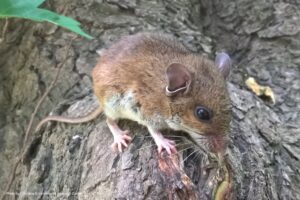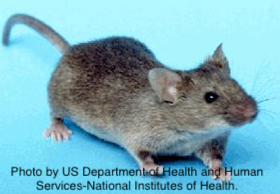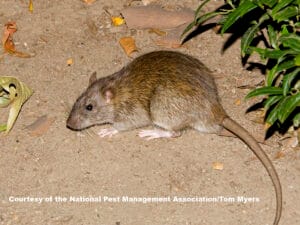Rodent Control & Extermination
Rats and mice can find their way into your home through extremely small holes. Once there, they may cause damage in their search for food or water, or when they build their nests. They have also been known to chew through wires and cause home alarm systems to go off! Mice and rats may also carry diseases that can affect humans (Hantavirus) or bring in disease-carrying fleas, ticks or lice. In some cases, you may not see the mice or rats, but may find droppings that indicate a problem. While you may be able to capture and remove the rodents, if you do not identify and seal every possible entry into your home, they are sure to return. If you have a problem with mice or rats, it’s time to call your local pest control heroes at Clegg’s! We have over 50 years of experience helping home and business owners with rats and mice and we can help you too. Call us or schedule your FREE initial inspection through the form below!
How do I know if I have mice in my house?
The most obvious way to know you have a mouse problem is of course to see a mouse in your house, but there are definitely other ways to tell if a mouse has set up residence in your home. These signs of mice or rats include, but are not limited to, the following:
Odd pet behavior: If your pet continually sniffs, watches, or scratches at a specific area of the house such as a crack between the stove and refrigerator, a specific wall, a space between moldings, etc, this could indicate rodent activity.
Bite Marks: If you notice small bite marks or scratch marks on food containers, wrappings, food items themselves, etc. you probably have a rodent problem. For example; if you had brownies covered in tin foil on your stove and in the morning there were little marks and slightly shredded tin foil around the brownies, you made a mouse very happy and it’s currently hiding somewhere enjoying its sugar high. Go ahead and toss those brownies out and call our team at Clegg’s!
“Grease trails”: These trails usually mean an infestation, and are usually a dirty looking mark along popular paths that the mice take when exploring/scavenging. These trails are left from the greasy residue from their bodies as well as from urine. These can appear anywhere, but typically will be under counter ledges, narrow places, against walls, etc. Mice tend to be more timid and travel against walls and areas where they feel less exposed.
Droppings or small hairs: Mice droppings look like small black pellets and can often be found around their food or water source. They can also be found in open food if the rodent has found a way in, such as an open cereal box, etc. It’s important to ensure any mice droppings are properly cleaned up and handled, as they can carry diseases harmful to humans. It’s also important to ensure there are no readily available food/water sources for rodents to get into, including pet food, as these attract rodents and make it very hard to break the feeding/breeding cycle. If you spot mouse droppings, call in the pros at Clegg’s.
Nests/nesting materials: A typical house mouse nest will look like a small 4-6 inch ball of shredded material. Materials can be insulation, paper, pillow batting, string, fabric, etc. If you see any of these things shredded in your house, go ahead and give us a call.
Scratching or scuttling noises: Often if you have a larger infestation, you will hear it before you see it. Rats are notorious for hanging out in attics, and can be heard most at night when they come out to scavenge for food. Mice on the other hand can often fit into small holes or spaces where baseboards don’t meet, moldings don’t come down entirely flush with the floor, or any small hole the size of a pencil eraser, leading them to establish residency inside of walls
If you have noticed any of these signs of rodent activity in your home, contact your local Clegg’s pest control heroes and let us get to work getting those critters out of your home!
Common Rats and Mice in North Carolina
Deer Mice

The deer mouse rarely invades homes and is found in rural areas.
Color: Brown, with white feet and underbelly
Size: 5 to 8 inches long
Habits: The deer mouse prefers the outdoors.
Habitat: The deer mouse makes its home outdoors in sheltered areas such as hollow tree logs or piles of debris. On the rare occasions the deer mouse comes indoors, it prefers undisturbed areas such as attics.
Threats: The deer mouse transmits the potentially fatal Hantavirus Pulmonary Syndrome. The disease can be transmitted through contact with mouse carcasses, or by breathing in aerosolized urine droplets of infected deer mice.
Prevention: To keep mice and other rodents out, make sure all holes of larger diameter than a pencil are sealed. Mice can squeeze through spaces as small as a nickel. Seal any cracks and voids. Don’t overlook proper drainage at the foundation and always install gutters or diverts which will channel water away from the building. Use heavy gloves and protective breathing gear when working in an area populated by deer mice.
House Mice

The house mouse is the most common rodent pest in most parts of the world. It can breed rapidly and adapt quickly to changing conditions.
Color: Light brown to black
Size: 2″
Habits: House mice can breed throughout the year and can share nests.
Habitat: House mice live in structures, but they can live outdoors.
Threats: Micro droplets of mouse urine can cause allergies in children. Mice can also bring fleas, mites, ticks and lice into your home.
Prevention: To keep mice and other rodents out, make sure all holes of larger diameter than a pencil are sealed. Mice can squeeze through spaces as small as a nickel. Seal any cracks and voids. Don’t overlook proper drainage at the foundation and always install gutters or diverts which will channel water away from the building.
Norway Rat

These rats have smaller eyes and ears and shorter tails.
Color: Gray, brown or black
Size: 10 to 12 inches (8″ body plus 4″ tail)
Habits: Rats are excellent climbers and often enter a home in the fall when outside food sources become scarce.
Habitat: Norway rats live in fields, farm lands and in structures. Rats are often found in woodpiles. Rodents can gain entry to a home through a hole the size of a quarter.
Threats: Rats can chew through wiring, causing fires. They also spread numerous diseases.
Prevention: Keep firewood stored well away from the structure. Remove debris piles. Seal any holes larger than 1/4 inch. Remove moisture and harborage sources.
Roof Rats

Roof rats get their name from their tendency to be found in the upper parts of buildings. Ranging in size from 6 to 8 inches in length, not including their tails, they have very poor vision and are color blind. They do have extremely strong senses of hearing, smell, touch and taste.
Color: Black
Size: 16″ total (6-8″ body plus 6-8″ tail)
Habits: Roof rats are known for the damage they cause by chewing on materials and eating stored foods.
Habitat: Roof rats can be found in the upper parts of buildings, and can also be found under, in and around structures. They only need a space of one-half inch to get into buildings.
Threats: Roof rats secured their place in history by spreading the highly dangerous bubonic plague. They support many ectoparasites and urinate on food.
Prevention: To prevent rats from entering a home, seal up any holes or cracks larger than a quarter. Remove sources of moisture and harborage.
“How Did The Mice Get In?”
There are a variety of entry possibilities:
- Construction near or around your home usually brings rodents.
- Unsealed holes in and around your home (underneath sinks, dryer vents, cracks in foundation, etc.) allow rodents to access your home. Steel wool is a wonderful tool to seal these openings.
There are several options available to eliminate mice and rats. A service technician will recommend the best option after determining your specific situation.
Rodent Control Throughout North Carolina
Did you know our pest control heroes service throughout all of North Carolina? Here are some of the main markets we are proud to serve:
If you think you have a problem with mice or rats, it’s time to call your local pest control heroes! Call us or request your FREE initial inspection online to eliminate the rats and mice before they reproduce or cause additional damage.
CLEGG’S PEST CONTROL CAN SOLVE YOUR ANT PROBLEM
If you have ever seen an ant in your house then you know that there is never just one. Ants live in large groups called colonies. Often times their nests are underground or inside trees, but sometimes ants move in and make their colony in the walls of a house or building. Inside of your home, ants can nest behind baseboards, moldings, countertops, inside walls, or even in your dishwasher. A single ant colony can live and reproduce for years with one queen, making them extremely hard to get rid of if they have set up residence in your home. Depending upon where the colony has made its nest, you may need to contact our team to control the infestation.
Surprisingly, what ants are attracted to actually changes throughout the year depending on where they are in their mating cycle. In the spring for example, when they are just beginning the mating and colonizing phase, they tend to be more attracted to high protein foods such as meat scraps left in the trash, peanut butter, other insects, or fats like grease, oil, and butter. As the summer continues, the new generation of ants requires more quick energy to grow and expand the nest so the ants will seek carbohydrates to eat for energy. This leads ants to be more attracted to sweets like crumbs and leftovers, spilled drinks, and garden produce.
No matter if the ants are entering your home in search of the food source they need, or if they have built up a residence in your walls, most people agree that getting them out is necessary. Contact our team to schedule your FREE initial inspection and get rid of ants in your home today.
TYPES OF ANTS
ODOROUS HOUSE ANTS
These ants have one node that is hidden by their abdomen and are dark brown to black in color. They are most often found in kitchens. When this ant is crushed it emits a coconut odor which signifies its name. Like the Argentine Ants, these ants may be found under mulch, along foundations, or underneath some form of debris. As with many ants, food sources will draw them out. If you have mulch or debris around the foundation of your home then you need to ensure that all cracks and crevices are sealed to prevent an inside invasion. Locating the nest is the surest way to eliminate the infestation but this is very difficult therefore bait is used on the ant trails which will lead the toxin back to the colony.
ACROBAT ANTS
These ants are yellowish brown to dark brown and are a little longer than 1/8 inch. Their abdomen is heart shaped and when disturbed they try to carry their abdomen above the rest of their body. If nesting outdoors they usually nest in decaying or dead wood. When foraging indoors they like wood or a damp wall cavity to nest in. A spray treatment should be performed in all areas these ants are found and drilling may be required to treat any wall voids that have become infested.
FIRE ANTS
Fire ants are red with 2 nodes and a stinger which sets them aside from most other ants. Fire ants are usually found outdoors versus indoors however when they do venture indoors it is usually along the edge of carpet. If you follow the trail back to the entry point then the mound is usually not far. We treat the mound(s) itself as well as the trail of ants.
How to Get Rid of Fire Ants: Read Article
Fire Ant Queen: Read Article
Fire Ant Mound: Read Article
CARPENTER ANTS
Carpenter ants have one node (circled) and an evenly rounded thorax. Carpenter vary is color and size but most are large and a blackish color. Parent colony lives in constant moisture. Satellite colonies are usually involved in infestations. Carpenter ants are most active at night, and the sound of a colony resembles that of wrinkling up cellophane. Colonies may exist in several areas including: wood, wall voids, hollow voids, under insulation, etc. Treatment usually involves the use of a dust and/or aerosol to flush out the existing colony.
Signs of Carpenter Ants: Read Article
Carpenter Ant vs Termite Damage: Read Article
Carpenter Ant Queen: Read Article
Carpenter Ant Bite: Read Article
What Do Carpenter Ants Eat: Read Article
FIELD ANTS
Field ants are black, brown, tan, reddish, or red and black in color. Field ants have 3 small eyes in the middle of their head (between their 2 compound eyes). Field ants are not usually found inside but rather around structures or under piles of wood, brick, or rocks. Once the colony is located, the mound itself is treated to eliminate the problem.
LITTLE BLACK ANTS
Black ants are tiny in size and are jet black in color. Little black ants occasionally invade homes but are usually found in the soil or nesting in the masonry or woodwork of a structure. Treating the colony itself is the best way to eliminate this ant. Indoor treatments may include the use of dust to treat wall voids.
How to Get Rid of Tiny Black Ants: Read Article
PAVEMENT ANTS
Pavement ants also have 2 nodes and are usually found in one of 3 places: 1) Outside along the foundation 2) Beneath slab foundation 3) Inside hollow foundation walls. Pavement ants may also be found trailing along the edge of carpets. Displaced soil indicates colony locations. They are a small brown to black ant with pale legs; their abdomen is black. Treatment is most successful when the colony itself is located and then treated. Depending on colony site, drilling may be required in order to apply the appropriate chemical.
PHARAOH ANTS
Pharaoh ants have 2 nodes (circled left) and are usually found traveling wires, the plumbing in walls, or inside wall outlet boxes. Baiting is the only effective treatment method for pharaoh ants. Pharaoh ants are known to have many colonies therefore all ant trails need to be baited. They are very small ants, usually light yellow to red in color with black markings on their abdomen.
CITRONELLA ANTS
Citronella Antsare usually light yellow to light reddish brown with small eyes and they have a citronella odor when crushed. Nest sites usually include open pastures, gardens, lawns, or around a home’s foundation. They may also be found underneath a concrete slab or inside of or underneath a timber that has become rotten. There are 2 species: the worker and the swarmer. The swarmers are almost twice the size of the workers and have smoke colored wings. Once colony is located the mound itself is treated to eliminate the problem.
ARGENTINE ANTS
Argentine Ants are a one node ant and that one node is sharply peaked. They are usually dull brown in color and when they are crushed a musty odor usually follows. Argentine ants are usually found outside under mulch, foundation slabs, or inside of a tree or shrub. We check all items that come in contact with the soil and treat all mounds that are located. On some occasions drilling may be required in order to treat a void that a colony may be inhabiting.
GHOST ANTS
Ghost Ants are a one node ant, very small in size, and pale in color. A rotten odor is emitted when ghost ants are crushed. Eliminating harborage sites around the foundation of a structure will help reduce the chance for an infestation of ghost ants. Ghost ants also travel inside along carpet edges, moldings, windowsills, electrical outlets, and any area near a water source. Finding the nest site by following the trail is the key to eliminating the infestation.
CRAZY ANTS
Crazy Ants are a one node ant, relatively small in size. They have extraordinarily long legs and are dark brown to blackish in color. Crazy ants are most easily identified by their zig-zag like movement. The crazy ant adapts very well to its environment whether it is a dry or wet habitat. We check all items that come in contact with the soil and treat all mounds that are located. On some occasions drilling may be required in order to treat a void that a colony may be inhabiting.
WHITE FOOTED ANTS
White Footed Ants have a hidden node. Its body color is darker than that of the odorous house ant and the end of their legs are a yellowish white color. These ants like to nest in soil, in old trees, and various other damp locations that have may provided a good nesting site. Their 2 preferred sources of food are dead insects and food with lots of sugar. Once the colony has been located the mound needs to be treated in addition to a perimeter spray performed around the infested site.
BIG HEADED ANTS
Big Headed Ants are a dimorphic species which means the worker ants vary in size. These ants are small in size and are yellowish or light to dark brown in color. The major worker has a large head for its body size whereas the minor worker’s head is more proportionate to its body size. These ants will nest in open areas but are usually found in the soil beneath a protective covering such as firewood or landscape timbers. Individual mounds should be drenched to eliminate the colony. Bait is effective for indoor treatments.
THIEF ANTS
Thief ants have 2 nodes, very small eyes, and is yellow to light brown in color. These ants normally nest outside in the soil underneath rocks. If these ants move inside they usually nest in wall voids or behind baseboards. Nests are hard to locate because they will travel long distances for food. These ants eat almost anything but prefer meats, fats, and grease. Ant bait is the most effective control method to use for thief ants.





